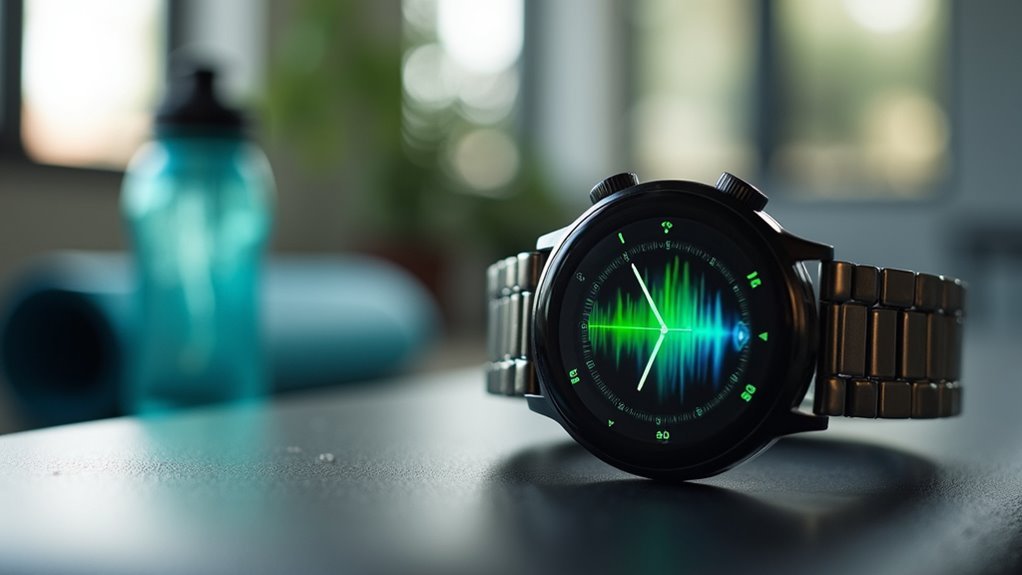You’ll access superior recovery results when you leverage your smartwatch’s three most powerful tools: heart rate variability monitoring, training load analysis, and sleep quality tracking. HRV measurements reveal your autonomic nervous system’s balance, helping you determine if you’re ready for intense training or need rest. Training load metrics combine workout intensity and duration to prevent overtraining, while sleep tracking provides recovery scores based on multiple physiological markers. Master these features to transform your recovery strategy.
Heart Rate Variability Monitoring for Recovery Assessment

While traditional recovery assessment often relies on subjective feelings of fatigue, heart rate variability (HRV) monitoring provides an objective, data-driven approach to understanding your body’s recovery status.
HRV measures the variation in time between heartbeats, reflecting your autonomic nervous system’s balance between sympathetic and parasympathetic branches. Your smartwatch analyzes common parameters like SDNN and rMSSD to determine how well you’re adapting to stress and training loads.
Higher HRV generally indicates better recovery, while lower readings suggest stress or inadequate rest. Since baseline HRV varies considerably among individuals, you’ll need personalized monitoring to establish meaningful trends. For optimal accuracy, your smartwatch should collect HRV data for 2 to 5 minutes to generate reliable averages.
Training Load Analysis and Performance Feedback Systems
Building on HRV insights, your smartwatch transforms raw physiological data into detailed training load metrics that quantify exactly how much strain you’re placing on different body systems.
Your device calculates Cardio Load from heart rate data, Muscle Load from movement patterns, and integrates your Rate of Perceived Exertion for thorough analysis.
You’ll receive a singular Training Load value per workout that combines time and intensity data.
Your weekly scores aggregate into trends that reveal whether you’re pushing too hard or maintaining ideal progression. The threshold HR zones distribution shows exactly where you’re spending training time, helping you adjust intensity accordingly.
Your smartwatch recommends personalized load ranges based on your habits, preventing overtraining while maximizing adaptation through balanced exertion and recovery cycles. The system compares your recent strain to tolerance ratios to determine if you’re in a productive training phase or need additional recovery time.
Sleep Quality Tracking and Recovery Optimization
Beyond measuring your daily activity, your smartwatch becomes a sophisticated sleep laboratory on your wrist, collecting heart rate, HRV, movement patterns, breathing rate, and skin temperature throughout the night.
While devices like Apple Watch achieve 97% accuracy detecting sleep versus wakefulness, they’re less precise identifying specific sleep stages—typically correct only 50-61% of the time for light, deep, and REM phases.
Sleep stage detection remains smartwatch technology’s biggest limitation, with accuracy rates hovering around 50-60% despite excellent sleep-wake detection.
Your recovery scores combine sleep data with HRV and resting heart rate to gauge physical readiness. High HRV and low resting heart rate generally indicate peak recovery.
You’ll receive actionable insights like bedtime recommendations and rest day suggestions. These insights can help you recognize how lifestyle choices like caffeine intake, meal timing, and stress levels impact your sleep quality and recovery. This real-time feedback helps you enhance training schedules, prevent overtraining, and make lifestyle adjustments that improve recovery quality for peak performance.
Frequently Asked Questions
How Long Should I Wait Between Workouts According to My Smartwatch?
Your smartwatch typically suggests 12-48 hours between moderate workouts, though recovery times vary based on intensity, duration, and your fitness level. Don’t follow it blindly—combine recommendations with how you’re actually feeling.
Can Smartwatch Recovery Tools Help Prevent Overtraining Injuries?
Yes, smartwatch recovery tools can prevent overtraining injuries by monitoring your heart rate variability, tracking sleep quality, detecting elevated resting heart rate, and alerting you when you’re pushing beyond your body’s recovery capacity.
Which Smartwatch Brands Offer the Most Accurate Recovery Tracking Features?
Apple Watch, Garmin, and Polar offer you the most accurate recovery tracking. Apple’s heart rate monitoring excels with minimal error, while Garmin’s Body Battery and Polar’s athlete-focused algorithms provide precise recovery insights for training optimization.
How Do I Sync My Smartwatch Data With Healthcare Providers?
You’ll sync your smartwatch data with healthcare providers by using FHIR-compatible apps, sharing data through your device’s health platform, or requesting direct EHR integration during appointments for thorough monitoring.
What Daily Step Count Indicates Proper Active Recovery Progress?
You’ll see proper active recovery progress with 7,500-10,000 daily steps. Start around 5,000 steps during early recovery, then gradually increase. Your cardiovascular health improves considerably once you’re consistently hitting that 7,500+ range.
In Summary
You’ve got powerful recovery tools right on your wrist. By monitoring your HRV, you’ll know when your body’s truly ready for intense training. Training load analysis keeps you from overdoing it while maximizing performance gains. Sleep tracking guarantees you’re getting the restorative rest you need. Don’t just guess about your recovery—let these smartwatch features guide your decisions and help you train smarter, not harder.





Leave a Reply